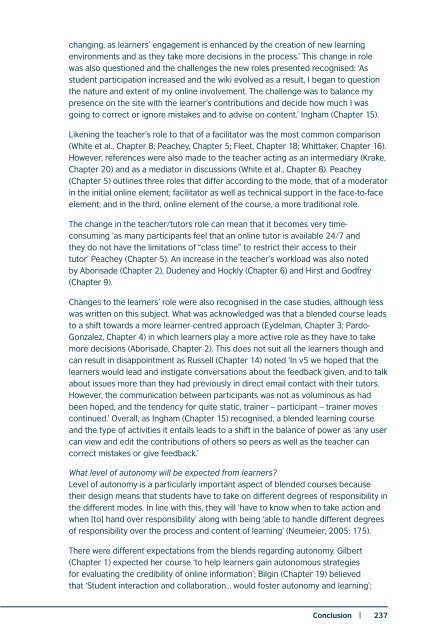Blended Learning in English Language Teaching: Course Design and Implementation
Blended Learning in English Language Teaching: Course Design and Implementation
Blended Learning in English Language Teaching: Course Design and Implementation
Create successful ePaper yourself
Turn your PDF publications into a flip-book with our unique Google optimized e-Paper software.
chang<strong>in</strong>g, as learners’ engagement is enhanced by the creation of new learn<strong>in</strong>g<br />
environments <strong>and</strong> as they take more decisions <strong>in</strong> the process.’ This change <strong>in</strong> role<br />
was also questioned <strong>and</strong> the challenges the new roles presented recognised: ‘As<br />
student participation <strong>in</strong>creased <strong>and</strong> the wiki evolved as a result, I began to question<br />
the nature <strong>and</strong> extent of my onl<strong>in</strong>e <strong>in</strong>volvement. The challenge was to balance my<br />
presence on the site with the learner’s contributions <strong>and</strong> decide how much I was<br />
go<strong>in</strong>g to correct or ignore mistakes <strong>and</strong> to advise on content.’ Ingham (Chapter 15).<br />
Liken<strong>in</strong>g the teacher’s role to that of a facilitator was the most common comparison<br />
(White et al., Chapter 8; Peachey, Chapter 5; Fleet, Chapter 18; Whittaker, Chapter 16).<br />
However, references were also made to the teacher act<strong>in</strong>g as an <strong>in</strong>termediary (Krake,<br />
Chapter 20) <strong>and</strong> as a mediator <strong>in</strong> discussions (White et al., Chapter 8). Peachey<br />
(Chapter 5) outl<strong>in</strong>es three roles that differ accord<strong>in</strong>g to the mode, that of a moderator<br />
<strong>in</strong> the <strong>in</strong>itial onl<strong>in</strong>e element; facilitator as well as technical support <strong>in</strong> the face-to-face<br />
element; <strong>and</strong> <strong>in</strong> the third, onl<strong>in</strong>e element of the course, a more traditional role.<br />
The change <strong>in</strong> the teacher/tutors role can mean that it becomes very timeconsum<strong>in</strong>g<br />
‘as many participants feel that an onl<strong>in</strong>e tutor is available 24/7 <strong>and</strong><br />
they do not have the limitations of “class time” to restrict their access to their<br />
tutor’ Peachey (Chapter 5). An <strong>in</strong>crease <strong>in</strong> the teacher’s workload was also noted<br />
by Aborisade (Chapter 2), Dudeney <strong>and</strong> Hockly (Chapter 6) <strong>and</strong> Hirst <strong>and</strong> Godfrey<br />
(Chapter 9).<br />
Changes to the learners’ role were also recognised <strong>in</strong> the case studies, although less<br />
was written on this subject. What was acknowledged was that a blended course leads<br />
to a shift towards a more learner-centred approach (Eydelman, Chapter 3; Pardo-<br />
Gonzalez, Chapter 4) <strong>in</strong> which learners play a more active role as they have to take<br />
more decisions (Aborisade, Chapter 2). This does not suit all the learners though <strong>and</strong><br />
can result <strong>in</strong> disappo<strong>in</strong>tment as Russell (Chapter 14) noted ‘In v5 we hoped that the<br />
learners would lead <strong>and</strong> <strong>in</strong>stigate conversations about the feedback given, <strong>and</strong> to talk<br />
about issues more than they had previously <strong>in</strong> direct email contact with their tutors.<br />
However, the communication between participants was not as volum<strong>in</strong>ous as had<br />
been hoped, <strong>and</strong> the tendency for quite static, tra<strong>in</strong>er – participant – tra<strong>in</strong>er moves<br />
cont<strong>in</strong>ued.’ Overall, as Ingham (Chapter 15) recognised, a blended learn<strong>in</strong>g course<br />
<strong>and</strong> the type of activities it entails leads to a shift <strong>in</strong> the balance of power as ‘any user<br />
can view <strong>and</strong> edit the contributions of others so peers as well as the teacher can<br />
correct mistakes or give feedback.’<br />
What level of autonomy will be expected from learners?<br />
Level of autonomy is a particularly important aspect of blended courses because<br />
their design means that students have to take on different degrees of responsibility <strong>in</strong><br />
the different modes. In l<strong>in</strong>e with this, they will ‘have to know when to take action <strong>and</strong><br />
when [to] h<strong>and</strong> over responsibility’ along with be<strong>in</strong>g ‘able to h<strong>and</strong>le different degrees<br />
of responsibility over the process <strong>and</strong> content of learn<strong>in</strong>g’ (Neumeier, 2005: 175).<br />
There were different expectations from the blends regard<strong>in</strong>g autonomy. Gilbert<br />
(Chapter 1) expected her course ‘to help learners ga<strong>in</strong> autonomous strategies<br />
for evaluat<strong>in</strong>g the credibility of onl<strong>in</strong>e <strong>in</strong>formation’; Bilg<strong>in</strong> (Chapter 19) believed<br />
that ‘Student <strong>in</strong>teraction <strong>and</strong> collaboration… would foster autonomy <strong>and</strong> learn<strong>in</strong>g’;<br />
Conclusion | 237


